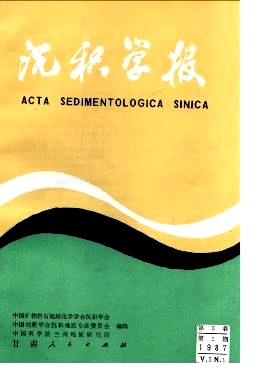CORRELATION OF TERRESTRIAL PETROLEUM IN CHINA AND AUSTRALIA AND DISCUSSION ON ITS FORMATION ENVIRONMENT
- Received Date: 1985-08-10
- Publish Date: 1987-03-10
Abstract: The majority of oil and gas in China and Australia formed in terrestrial sedimentary basins. Eleven oil samples collected from Eromanga Basin were provided generously by Australia Delhi petroleum Company in 1984. They were sampled from the Middle Jurassic-Early Cretaceous strata. On the basis of mass-spetrometer and capillary chromatogarphy analyses, they are characterised by paraffin-base crude oil with high ratio of pristane/phytane and heavy δ13C value. The compositions of samples are more or less alike, and carbon atom numbers of the principle peak distribute widely from C10 to C21 with a little isoprenoid and the ratios of Pr/nC17 and Ph/nC18 are 0.22-0.49, 0.04-0.09 respectively, only Brikhead oil samples of Charro have a high ratio of Pr/nC17 (0.74) . In accordance with the ratios of Pr/Ph, Pr/nC17 and Ph/nC18 the samples can be divided into three sub-groups approximately. The ratios of Pr/Ph in the three sub-groups A,B,C are 4.0-6.0, 6.0-6.5, 8.0-9.63 respectively, coinciding with the distribution pattern of hydrocarbon chromatogram. Theδ13C values of eleven oil samples range f rom-23 .53‰ to-26.24‰. A lot of scholars useδ13C (-2.6‰)as a boundary value to tell oils formed in marine environment from that in terrestrial. But geological data indicate that the samples are generated in terrestrial environment. According to the ratios of Pr/Ph, Pr/nC17 and Ph/nC18, the Chinese terrestrial petroleum can be classified into four types. TypeⅠ: The ratio of Pr/Ph is near 1.0 (0.87-1.39) with medium pristane and phytane content. The ratios of Pr/nC17 and Ph/nC18 are 0.18-0.61 and 0.15-0.77 respectively. It is generated in fresh-brackish lacustrine sediments. The majority of marine oils distribute in this range. Type Ⅱ: the ratio of Pr/Ph is less than 0.80(0.33-0.70), the phytane content is specially high, usually with predominant odd carbon numbers in lower carbon numbers, meanwhile the predominance of even carbon numbers in higher ones when phytane is regarded as a boundary. Type Ⅱ forms in saline lacustrine enviroment and some of marine crude oils formed in saline enviroment probably have this kind of characteristics. The ratio of Pr/Ph in Type Ⅲ is more than 2.50 (2.75-4.28) with very low content of isoprenoid and the ratios of Pr/nC17, Ph/nC18 are less than 0.85, 0.21 respectively. It is generated in river-lacustrine or swamp deposits. The environment of forming type Ⅳ is peaty-swamp or bog. The ratio of Pr/Ph is 7.23, while those of Pr/nC17, Ph/nC18 are 1.27, 0.18 respectively. Type Ⅲ and Type Ⅳ are similar in characteristics, however, there is a high content of isoprenoid in the latter. The value of C in the Chinese terrestrial petroleum distributes from -20‰to -32‰widely. Owing to the δ13C value of oils formed in salt lacustrine deposits and some of swamps is heavier than -26‰ as well, to authors opinion, it could not use the δ13C value (-26‰) to separate marine oils from terrestrial ones. However, on the basis of statistical probability, we can distinguish between fresh-brackish lacustrine and marine oils by using δ13C (-26‰) as a boundary value. This paper introduces a new graph which expresses the relationship between the ratio of Pr/Ph and the value of δ13C in determining the environments of oil formation. The different regions of the graphrespcct different geochemical environments in which variant types of crude oils are generated, such as Region Ⅰ: the fresh-brackish lacustrine, Ⅱ: the salt water lacustrine, Ⅲ: the river -lacustrine, Ⅳ: the peat-bog, Ⅴ: the marine.
| Citation: | Luo Binjie, Wang Youxiao, Shen Ping, Yang Xinghua, Zheng Guodong. CORRELATION OF TERRESTRIAL PETROLEUM IN CHINA AND AUSTRALIA AND DISCUSSION ON ITS FORMATION ENVIRONMENT[J]. Acta Sedimentologica Sinica, 1987, 5(1): 10-25. |






 DownLoad:
DownLoad: